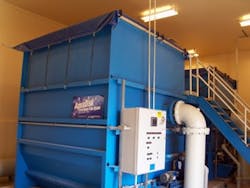Silver Spring Township Chooses SBR System with Cloth Media Filters for Wastewater Treatment
Problem
Silver Spring Township Authority’s wastewater treatment facility, located in Mechanicsburg, Pa., has been in operation since August 1990. The plant initially utilized an intermittent cycle extended aeration system but was in need of an upgrade after 18 years, because the existing system could not provide sufficient total nitrogen removal.
Solution
Silver Spring, and its engineer, Pennoni Associates, researched other technologies for the upgrade, including a membrane bioreactor and an aerobic/anoxic reactor with clarification. Ultimately, it chose a three-basin AquaSBR sequencing batch reactor (SBR) system and two AquaDisk cloth media filters . Preference for the AquaSBR system was due to its ample total nitrogen removal capabilities, derived from its anoxic mixing method. Also, the overall cost of the system was lower, due to the type and depth of tankage required for the new plant layout. Start-up of the new treatment system began in April 2009, serving a population of 1500 residential connections and 135 commercial customers.
Treatment System Operation
The AquaSBR system operates on a simple concept of introducing a quantity of waste to a reactor, treating the waste in an adequate time period and subsequently discharging a volume of effluent plus waste sludge that is equal to the original volume of waste introduced to the reactor. This “fill and draw” principle of operation involves the basic steps of fill, react, settle, decant and sludge waste. The system may be designed to include seven individual phases of operation, but the inclusion or duration of any individual phase is based on specific waste characteristics and effluent objectives.
Where nutrient removal is required, a simple adjustment to the SBR’s operating strategies permits nitrification, denitrification and biological phosphorus removal. Optimum performance is attained when two or more reactors are used in a pre-determined sequence of operation.
Clarified effluent from the AquaSBR system enters the AquaDisk filters and flows by gravity through the cloth media of the stationary hollow disks. Filtrate exits through the hollow shaft which supports the individual disks and flows to the effluent channel. As solids accumulate on the surface of the media, the water level surrounding the disks rises. Once a pre-determined water level is reached, the disks rotate and the media surface is automatically vacuum-backwashed clean. The heavier solids settle to the bottom of the tank and are then pumped to a digester or to the plant head works.
Design Characteristics and Operating Data
Silver Spring Township Authority’s AquaSBR system with AquaDisk filters was designed with the treatment objectives of nitrification, denitrification and phosphorus removal. Although the plant doesn’t require chemical addition to improve its effluent quality, it adds aluminum sulphate to the batch reactors to aid in additional PO4 removal.
“The AquaSBR system has exceeded our expectations with regard to Total Nitrogen removal, and the components are robust and easily maintained. Aqua-Aerobic has provided customer support for us since start-up,” said Authority Manager Jim Stevens.
Average Operating Data
| Loading | Design Influent | Avg. Influent | Design Effluent | Avg. Effluent |
| Avg. Flow (mgd) | 1.2 | 0.38 | --- | --- |
| Peak Flow (mgd) | 2.7 | 0.42 | --- | --- |
| BOD (mg/l) | 400 | 380 | 10 | 1.7 |
| TSS (mg/l) | 240 | 400 | 10 | 1.0 |
| Total N (mg/l) | 62 | --- | 6 | 3.0 |
| NH 3 -N | --- | 35 | 2 | 0.3 |
| Total P (mg/l) | 10> | 8.0 | 1 | 0.6 |
Total nitrogen effluent levels have decreased to approximately 3 mg per liter. Effluent total suspended solids are typically 1 mg per liter. The facility has plans to install a fourth AquaSBR basin when necessary, which will increase the average design daily flow to 1.6 million gal per day.
For technical questions or information, please contact Brandon Thomas, E.I.T. at 815.639.4489 or [email protected] or visit the company's website at www.aqua-aerobic.com/aquaExcel.asp and www.aqua-aerobic.com/aquaDisk.asp
